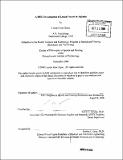| dc.contributor.advisor | Kevin P. Kearns. | en_US |
| dc.contributor.author | Zipse, Lauryn Rose | en_US |
| dc.contributor.other | Harvard University--MIT Division of Health Sciences and Technology. | en_US |
| dc.date.accessioned | 2009-08-26T17:14:26Z | |
| dc.date.available | 2009-08-26T17:14:26Z | |
| dc.date.copyright | 2008 | en_US |
| dc.date.issued | 2008 | en_US |
| dc.identifier.uri | http://hdl.handle.net/1721.1/46658 | |
| dc.description | Thesis (Ph. D.)--Harvard-MIT Division of Health Sciences and Technology, 2008. | en_US |
| dc.description | Includes bibliographical references (leaves 105-117). | en_US |
| dc.description.abstract | Aphasia is an acquired impairment of language ability that occurs secondary to brain damage, and auditory comprehension deficits are a defining component of aphasia. At the single-word level, these deficits are thought to arise from impaired phonological processing, semantic representations, or both. The present study examined spreading lexical activation in people with aphasia by implementing thorough clinical evaluation, a series of listening tasks, and a time sensitive means of tracking cortical activation. Magnetoencephalography (MEG) was used to measure the cortical activity of 7 people with aphasia, 9 age-matched control participants, and 10 younger control participants as they completed an auditory lexical decision task and a passive listening task with phonemes. In the lexical decision task, target words were presented in three conditions of interest: semantically primed, where the target was preceded by a related word; identity primed, where the target was preceded by itself; and a control condition, where the target was preceded by an unrelated word. Behavioral reaction times and MEG data were collected in response to each target, and the M350, a MEG signal associated with lexical processing, was evaluated. MEG data collected during the passive listening task were used to evaluate the mismatch field (MMF), a response associated with the formation of an auditory memory trace. Analysis was conducted at both the group and single-subject levels. | en_US |
| dc.description.abstract | (cont.) All groups showed identity priming of the M350 response, although this was seen in the amplitude dimension for the control groups but in the latency dimension for the group with aphasia. The older control group showed semantic priming of the M350 and the younger group showed a marginally significant priming effect, while the group with aphasia failed to show this effect. There was evidence that some people with aphasia may have a delayed or absent M350 response. Finally, the behavioral results indicated that the younger and older control participants were using different strategies to complete the lexical decision task. These findings highlight the potential importance of latency differences when analyzing electrophysiological responses in aphasic populations. Furthermore, they indicate that some cognitive-linguistic tasks may induce different types of processing in older and younger groups. | en_US |
| dc.description.statementofresponsibility | by Lauryn Rose Zipse. | en_US |
| dc.format.extent | 123 leaves | en_US |
| dc.language.iso | eng | en_US |
| dc.publisher | Massachusetts Institute of Technology | en_US |
| dc.rights | M.I.T. theses are protected by
copyright. They may be viewed from this source for any purpose, but
reproduction or distribution in any format is prohibited without written
permission. See provided URL for inquiries about permission. | en_US |
| dc.rights.uri | http://dspace.mit.edu/handle/1721.1/7582 | en_US |
| dc.subject | Harvard University--MIT Division of Health Sciences and Technology. | en_US |
| dc.title | A MEG investigation of lexical access in aphasia | en_US |
| dc.title.alternative | Magnetoencephalography investigation of lexical access in aphasia | en_US |
| dc.type | Thesis | en_US |
| dc.description.degree | Ph.D. | en_US |
| dc.contributor.department | Harvard University--MIT Division of Health Sciences and Technology | |
| dc.identifier.oclc | 427546331 | en_US |

